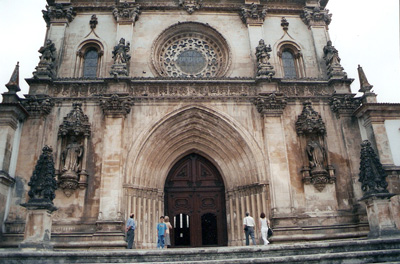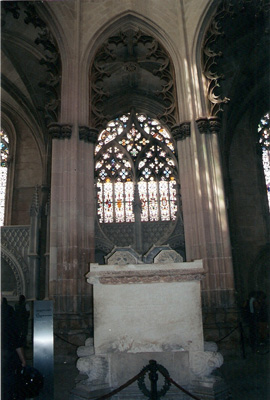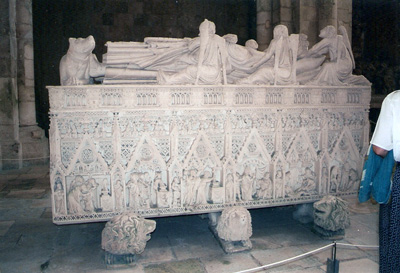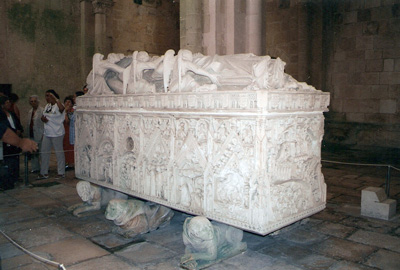
Front of the monastery
In 1339, D. Pedro, prince of Portugal and heir to the throne, married D. Constança Manuel, great-granddaughter of the king Fernando III of Castela. It was an agreed marriage, based on the importance of strategic alliances, as all the marriages between royal families used to be. But Constança brought with her, in her court, a chambermaid whose beauty would remain in History. Her name was Inês de Castro. This improvidence of the future queen would lead to disastrous consequences and to one of the most troublesome ages in the History of Portugal.
One day, in a ball in the palace, D. Pedro saw Inês. Fascinated by her beauty and graciousness, he couldn’t take his eyes of her. He fell in love with her and, for state reasons or not, his love was returned. (We all saw what happened in The other Boleyn girl, by Justin Chadwick) They started meeting and she had four children of the prince; three of them were boys.
It was normal and proper to a heir to have his concubines, and culturally no-one could blame him for that. But the problem here was the traditional rivalry between Portugal and Castela. Inês was great-granddaughter of the king Sancho IV of Castela. The relationship between her and D. Pedro afforded an approximation of the prince to her brothers, Fernando de Castro and Álvaro Pirez de Castro, individualities who had a huge influence in the court of Castela. Fearing for the independence, suspecting of conspiracy, the people and the noblemen of the reign disapproved this love story.
The relationship between D. Pedro e Inês de Castro soon came to knowledge of the king D. Afonso IV, who, in the name of moral and “good manners”, exiled Inês in the castle of Albuquerque, near the boundaries of the kingdom. But D. Pedro didn’t give up and they kept corresponding through messengers.

Ogival arch and vitral
In 1345, D. Constança died, giving birth to her first son and next in lineage, D. Fernando I of Portugal. D. Pedro was relieved and ordered Inês de Castro to come back to the north of Portugal. They started living together in his house and this fact had an enormous impact in the court. The scandal forced the king, D. Afonso IV to take drastic measures. He arranged a new marriage to D. Pedro, with a noble Lady whose name isn’t mentioned. D. Pedro refused, alleging that he was still mourning D. Constança and it was too soon to think of another marriage.
But the rumours were circulating that there was a new conspiracy to kill the legitimate heir to the throne, D. Fernando, and establish a son of their union as the future king.
D. Pedro and Inês de Castro moved from the north to Coimbra, in the Paços of Santa Clara; a residence which had been designed by Pedro’s grandmother, the queen Santa Isabel, to be a place where the heirs could live with their legitimate wives. Then, a new rumour was originated, that the heir had secretly married D. Inês. Such incident, if it was true, would have serious implications in the kingdom.
The king, D. Afonso IV, decided that the best solution was to order the killing of D. Inês de Castro. In the seventh of January 1355, the king sent Pêro Coelho, Álvaro Gonçalves e Diogo Lopes Pacheco to the Paços of Santa Clara, with the mission of killing Inês. So many tears Inês cried in the river Mondego that the Fountain of Love was created.

Here lies Ines
D. Pedro became the eighth king of Portugal in 1357. In 1360, he decided to legitimate his children, by declaring that he had secretly married Inês. There were no proofs of this marriage, except for the king’s word and the chaplain who supposedly did the ceremony.
Meanwhile, he chased the murderers of his beloved, who had run to Castela. The legend says that he tore one’s heart through his chest and the other one’s through his back. Then, he made a feast.
D. Pedro raised his beloved from the tomb and did a procession with her through Portugal. Everybody was forced to kiss her hand and to salute her as the queen. Even though she was dead, the coronation ceremony was properly accomplished.
D.Pedro ordered the elaboration of two magnificent tombs, which can be seen in the Alcobaça Monastery, and removed his beloved’s body to this sacred place. He joined her in 1367. Their bodies lie face to face, so that, in the revival day, the first thing that they see is each other.

This is Pedro's tomb
![Reblog this post [with Zemanta]](https://i0.wp.com/img.zemanta.com/reblog_e.png)




